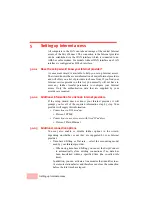
Configuration examples
3-18
• SIP ID / user: Enter the SIP number with local area code here,
providing that the SIP provider does not require any other
information.
• Display name (optional): The display name is only required if
the SIP provider verifies this during registration. If you enter
a display name here, then this name will be displayed at the
remote site. If the field remains empty, then the display name
for the corresponding internal user is transmitted.
• Authentication name (optional): Special authentication names
are not supported by all SIP providers. In many cases, the
authentication name is the same as the SIP ID or the user
name. Complete this field only if your SIP provider has
issued you a special authentication name.
• Password: Enter the password for SIP access here.
4.
Enable the internal ISDN bus at all ISDN interfaces in order to
use the VoIP functionality. Select all ISDN interfaces to be used
for internal ISDN users and terminal equipment.
5.
Enter one common ISDN user for all of the connected ISDN
terminal devices. For each of these, enter the placeholder '#' as
'Internal number' and 'MSN/DDI'. This ensures that extension
numbers coming from the Call Manager are forwarded to the
internal ISDN busses without being changed.
6.
Enable spontaneous outside line access for ISDN and SIP users
in order to keep the subscribers' telephone behavior as
consistent as possible.
7.
The call routing table suggested by the setup wizard
automatically allows spontaneous outside line access for ISDN
and SIP users
and
.
As a result of both of these routes, any stars '*' that might have
preceded the numbers are removed before each call from a local
user. For all other calls from local users, the number is preceded
with a '0', as it is automatically assumed that the user is trying to
establish an outside connection.
Summary of Contents for SwyxConnect 1722
Page 112: ...I 5 ...
















































